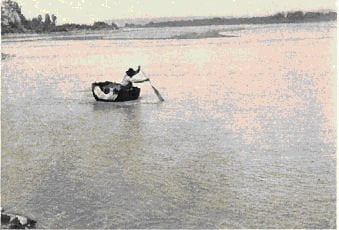Almost without exception, the Village group of tribes made at least some attempts to cultivate maize. Of the northern tribes, none have been credited with this practice, except perhaps the Teton-Dakota.
Yet, the earlier observers usually distinguish the Teton from the Eastern Dakota by their non-agricultural habits. Of the southern tribes, we cannot be so sure. The Cheyenne, who seem to have abandoned a forest home for the plains just before the historic period have traditions of maize culture, but seem to have discontinued it soon after going into the buffalo country. The Arapaho are thought by some anthropologists to have preceded the Cheyenne. Yet while many writers are disposed to admit that all of the southern group may have made some attempts at maize growing, they insist that these were feeble in comparison with the Village tribes. When, however, we turn to the Plateau area, there are no traces of maize growing. In association with maize it was usual to raise some varieties of squash and beans.
Thus, in a general way, the practice of agriculture seems to dwindle out gradually as we leave the more fertile river bottoms of the east and south, suggesting that its positive absence among the extreme western and northern tribes is due to unfavorable soil and climate rather than to any mental or social differences in the tribes concerned. This is consistent with the wide distribution of tobacco raising. The Blackfoot, Crow, Hidatsa, Mandan, Arikara, Pawnee, and Eastern Dakota are known to have cultivated it for ceremonial purposes.
The plants have not been closely studied, but that of the Hidatsa and Mandan is Nicotiana quadrivalvis. It is probable that this is the species among the other tribes, with the exception of the Crow and Blackfoot.
The latter has been pronounced Nicotiana attenuata and Crow tobacco is multivalvis. The last is said to be a native of Oregon and to have been cultivated by tribes in the Columbia River valley. The fact that the Blackfoot and Crow did not attempt any other agriculture except the raising of this tobacco rather strengthens the previous opinion that maize was not produced be cause of the unfavorable conditions. Among the tribes of the Plateau area, on the western border of the Plains, wild seeds and grains were gathered and so took the place of maize in the east. So we find the Shoshoni and Ute making some use of such foods. On the other hand, the northern and southern Plains groups, de pended mostly upon dried berries and edible roots, which, however, were a relatively small part of their diet, buffalo flesh being the important food. This was particularly true of the nine typical tribes. With these tribes, the buffalo was not only food: but his by products, such as skin, bones, hair, horns, and sinew, were the chief materials for costume, tents, and utensils of all kinds.


